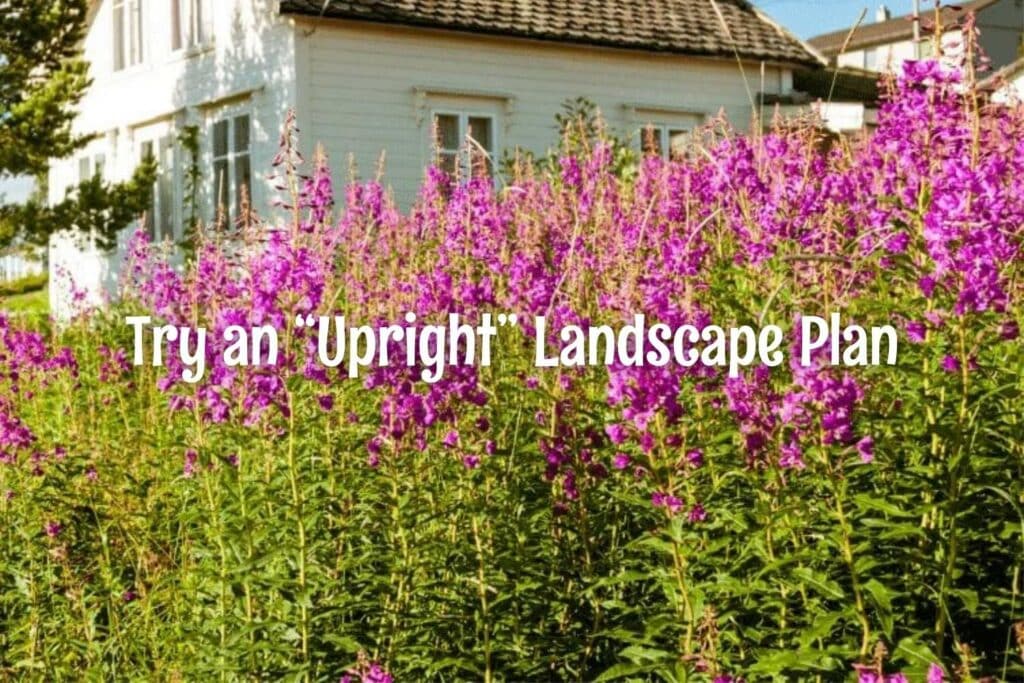
The Art of Color Echo
by Laurie Brown
Combining colors in the garden is a source of great fun for me. drifts of lavender, spikes of blue – will it go together? How much of each?
One good way to pull colors together is for one plant to echo the color of another. This can be subtle – a yellow flowering sedum below a rose which has golden stamens in its pink petaled flower – or bold purple pansies low on the ground repeating the color of the “King Arthur” delphiniums, five feet higher.

The “echo” may not be the main color of the composition, at least not in the area where the color is concentrated. You could, for instance, have a bed of bright pink summer phlox, with bright pink petunias at the phlox’s feet. This is less an echo than a statement. If you repeated that pink, however, with the fuzzy pink flowers of a spirea across the yard, that is an echo. However bright the color might be, the echo does not shout, it chimes.
This echo can be contrived in several ways – use of the same color, but paler or deeper, picking out a color that is not dominant in a plant (such as the stamens) and repeating it with a flower of that color, using the same color but in different shapes (spikes, drifts), and highlighting a color that isn’t in the flower itself at all – berries, stems, leaves, or even furnishings.
For instance, strictly by accident, I planted a red-twigged dogwood close by a mountain ash. In winter the red ash berried look splendid with the red dogwood stems. Similarly, as this dogwood is variegated and turns two shades of purple in fall, I hope to someday find just the right color of aster to go with it. The yellow center of the aster would, in turn, echo the golden leaves of the rugosa rose on the other side of the ash.

The flowers of the marshmallow are a pale, mauve-y pink, but in the very center is a little purple dot. The dot is much more obvious when there is a group of wood betony, with their violet spikes, around the mallow. In this same manner, if you can contrive to plant Nicotiana langsdorfii up where you can see into its green, bell shaped flowers, you’ll see blue stamens that can be beautifully echoed by Delft Blue pansies. And those same N. langsdorfii, planted by a daylily with a green throat, makes one notice that throat much more, by bringing the color to mind.
The color that you wish to echo need not be so subtle, however. If, say, you like pink roses, but don’t want the garden to be awash with one solid color, pick your favorite pink and plant several in that color. Then add a few very pale pink, almost white, roses, perhaps one that is striped pink and white, and maybe Mme. Isaac Pereiere, a deep, almost raspberry pink. This variation will give more of a tapestry effect than that of a block of color, and be much gentler on the eyes.
Or maybe you’d like to tie the garden together, despite having flowers of several colors. Why not use a “blender” color, repeated about the entire garden? Put some grey-barked birches in a couple of places. Then place fuzzy grey lamb’s ears along the path and artemisias in among the tall border plants, lay some driftwood in a low bed, and stain the gate with grey to make it look weathered. However riotous the other colors in the garden, this will tame them down.
What about a drift of lavender petunias? Boring? But look how it goes with those spiky purple veronicas and salvia superba. Not to mention the mounded heliotropes and lavender plants. And if you’re lucky enough to have a wisteria of sufficient age to bloom – or a velvety purple clematis – perfect!
Want something that will inject a cooling note into your garden? Put in a blue spruce. Then create a refrain of that color with a bed of blue-leaved hostas. Perhaps an alba rose or two, with their bluish, greyish-green leaves. Some blue fescues, and lacy leaved rue; a mound or two of Cheddar pinks – it almost has the effect of a water feature in the garden.
Echos can be transitory, too. While moving the sprinkler a bit ago, I noticed that the last few flowers of my William Lobb rose, normally a deep red that ages to purple, have turned to bright, deep pink, probably from the recent heat. They match perfectly the pink mullein that has seeded itself into that bed. While this effect will only last a few more days, it is quite delightful. I think I’ll go admire it some more.
Originally published 7/22/01 in the Bonner County Daily Bee.







Laurie-
Do you have those beautiful, gigantic, healthy tomato plants for sale this year? I don’t have any wheels at the moment, so could you please save 6 of them for me? Thanks much!